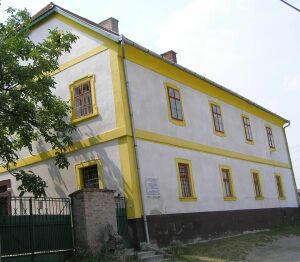Roman Catholic Parsonage
Translated by Dóra Lukács
According to the charters and the papal tithe-rolls, Érd already had a parsonage and a church in the 13th century. The ground floor of the baroque parsonage, a registered monument standing on Molnár Street, was built under the ownership of Péter Szapáry between 1685 and 1695. Bosnian Capistrano grey friars founded the parish after the Turks had been driven from the country. In 1774, when János Tomicich was the parson, Count János Illésházy expanded the parsonage with a second storey. In the same year, the tower of the Roman Catholic church was built.
On the front of the two-storey, rectangular building, there are four stone-framed windows on both floors, and there is a divisor stripe between the levels, indicating the different periods. The eaves ledge is concave. There are two small semicircular attic blowholes on the gables. During the last renovation, the different building periods were indicated with different colours. In the rooms downstairs we can view the early baroque dome vaults peculiar in the end of the 17th century.
We know the layout of the first and second storeys from Ferenc Wajthay’s notes from 1846: Stepping through the stone-framed entrance, we arrive in a small hall. The staircase and the corridor leading to the rooms on the ground floor are in front of us. Downstairs, there were a bigger room and an antechamber opening from that, a kitchen with an enormous stove and a freestanding chimney and a dining room opening from the kitchen, and a pantry at the end of the corridor. The parson could get down to the cellar through the stone-framed hatchway from the yard. The room and the dining room were heated with several stoves. The parson’s and the chaplain’s bedrooms were upstairs, which were also kept warm with tile stoves in winter. Outside a stable, a pantry and a shed join the building in an L shape. Some parts of these outbuildings are still visible.
Gyula Kereskényi carefully collected the names and activities of the priests working in the parsonage since 1718. The parish registry also started in 1718. The layout of parsonage remained the same since then; the rooms from the last survey can be easily identified today.
The statues that adorned the fence of the Saint Sebastian, Saint Rokus and Saint Rosalia Votive Chapel can now be found in the courtyard of the parsonage. Unfortunately some of them are only fragments of the originals. The more or less intact Pieta is especially beautiful.
